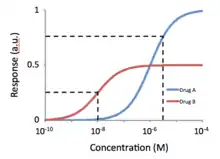
In pharmacology, potency or biological potency[1] is a measure of a drug's biological activity expressed in terms of the dose required to produce a pharmacological effect of given intensity.[2] A highly potent drug (e.g., fentanyl, clonazepam, risperidone, benperidol, bumetanide) evokes a given response at low concentrations, while a drug of lower potency (e.g. morphine, alprazolam, ziprasidone, haloperidol, furosemide) evokes the same response only at higher concentrations. Higher potency does not necessarily mean greater effectiveness or more side effects.
Types of potency
The International Union of Basic and Clinical Pharmacology (IUPHAR) has stated that "potency is an imprecise term that should always be further defined",[2] and lists of types of potency as follows:
| Type of potency | Symbol | Definition |
|---|---|---|
| Effective dose | It is the minimum dose or concentration of a drug that produces a biological response in 50% of a population being studied. | |
| Median lethal dose | For either drugs or toxins, it is a toxic unit that measures the minimum dose that causes death (lethal dose) in 50% of cases. | |
| Median toxic dose | It is the minimum dose at which toxicity occurs in 50% of cases. | |
| Half maximal effective concentration | It is a measure of the concentration of a drug, antibody or toxicant which induces a biological response halfway between the baseline and maximum after a specified exposure time. In other words, it can be defined as the concentration required to obtain a 50% effect.[3] | |
| Half maximal inhibitory concentration | It is a measure of the potency of a substance in inhibiting a specific biological or biochemical function. |
See also
References
- ↑ MILES AA, PERRY EL. Biological potency and its relation to therapeutic efficacy. Bull World Health Organ. 1953;9(1):1-14. PMID: 13082386; PMCID: PMC2542104.
- 1 2 Neubig RR, Spedding M, Kenakin T, Christopoulos A (December 2003). "International Union of Pharmacology Committee on Receptor Nomenclature and Drug Classification. XXXVIII. Update on terms and symbols in quantitative pharmacology". Pharmacological Reviews. 55 (4): 597–606. doi:10.1124/pr.55.4.4. PMID 14657418. S2CID 1729572.
- ↑ "Introducing dose response curves". Graphpad Software. Archived from the original on 2012-07-30.
Further reading
- Harris, Robert (2012-10-09). "Formulating High Potency Drugs". Contract Pharma. Retrieved 2013-11-13.
- Walker MG, Page CP, Hoffman BF, Curtis M (2006). Integrated Pharmacology (3rd ed.). St. Louis: Mosby. ISBN 978-0-323-04080-8.
https://www.addictioncenter.com/news/2019/08/15-most-dangerous-drugs/ https://nida.nih.gov/research-topics/commonly-used-drugs-charts#top